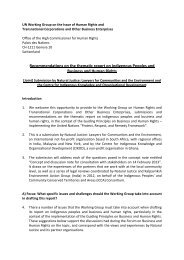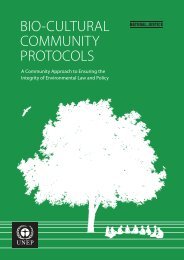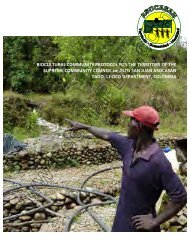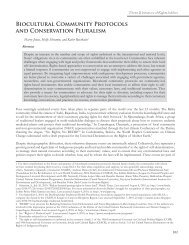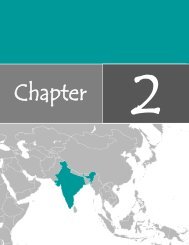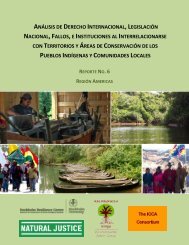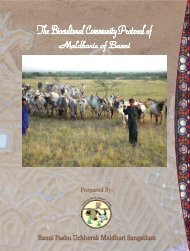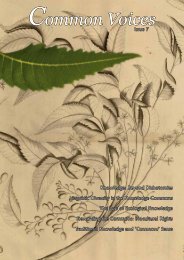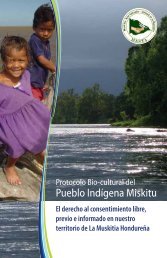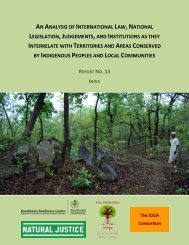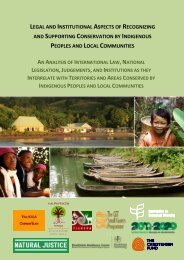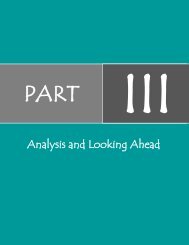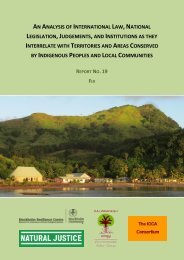Analyzing The Binding Nature of COP Decisions ... - Natural Justice
Analyzing The Binding Nature of COP Decisions ... - Natural Justice
Analyzing The Binding Nature of COP Decisions ... - Natural Justice
Create successful ePaper yourself
Turn your PDF publications into a flip-book with our unique Google optimized e-Paper software.
under the catchall provision in Article 23, which allows the CBD to “[c]onsider and undertake any additional action that may be required for the achievement <strong>of</strong> the purposes <strong>of</strong> this Convention[.]” 43Rule 40 <strong>of</strong> the CBD <strong>COP</strong> Rules <strong>of</strong> Procedure (“Rules <strong>of</strong> Procedure”) addresses decision-making on matters <strong>of</strong> substance and provides the following: [1. <strong>The</strong> Parties shall make every effort to reach agreement on all matters <strong>of</strong> substance by consensus. If all efforts to reach consensus have been exhausted and no agreement reached, the decision... shall, as a last resort, be taken by a two-‐thirds majority vote <strong>of</strong> the Parties present and voting, unless otherwise provided by the Convention... or the present rules <strong>of</strong> procedure...] 44Unlike provisions governing adoption <strong>of</strong> protocols and amendments to the CBD, reaching a decision under Rule 40 does not require ratification by Parties. It is also unclear under Rule 40 whether parties who were not present and voting or who voted against the decision are bound by it. 3.4.3 Legal Weight 45 <strong>of</strong> CBD <strong>COP</strong> Actions Under traditional treaty law analysis, the actions 46 <strong>of</strong> the <strong>COP</strong> which most closely approximate traditional treaty formation – adoption and ratification – will constitute Article 32(2) provides that “<strong>Decisions</strong> under any protocol shall be taken only by the Parties to the protocol concerned.” 43 Stan Stevens, the Treasurer for the Indigenous and Community Conserved Areas consortium, provides anecdotal evidence. At the GEF Council meetings with civil society in November 2011 he was told by a policy <strong>of</strong>ficer in GEF Secretariat that the GEF Council did not consider PoWPA to have the same weight as CoP decisions because it is “only an annex” to a CoP decision. Subsequently he was told that the GEF Council maintained that they did not need to include FPIC because “FPIC is only mentioned in PoWPA, and not in a CoP decision.” 44 Brackets in original. In a rather ironic twist, the entirety <strong>of</strong> Rule 40 is bracketed “due to the lack <strong>of</strong> consensus among the Parties concerning the majority required for decision-‐making on matters <strong>of</strong> substance.” CBD, Report <strong>of</strong> the Tenth Meeting <strong>of</strong> the <strong>COP</strong> to the CBD, 20 January 2011, at Paragraph 65. As <strong>of</strong> <strong>COP</strong> 10, “[t]he Conference <strong>of</strong> the Parties did not currently appear to be in a position to adopt those outstanding rules so the President suggested postponing discussion <strong>of</strong> the issue to the eleventh meeting <strong>of</strong> the Conference <strong>of</strong> the Parties.” Id. It is hoped that by <strong>COP</strong> 11, the <strong>COP</strong> will be able to finally reach a consensus on its rules for reaching a consensus. 45 <strong>The</strong> term “legal weight” is used here to refer to whether the CBD <strong>COP</strong> action is binding or non-‐binding.



